Japanese Traditional Music Show Created by Shamisen
Within the realm of traditional Japanese music, a captivating showcase unfolds, featuring the exquisite artistry of the shamisen. This cultural spectacle, steeped in heritage and artistry, invites audiences to witness the intricate fusion of past and present through the resonant strings of this iconic instrument.
With each performance, a tapestry of emotions is woven, offering a glimpse into the profound depths of Japan’s musical tradition. Stay tuned as we unravel the layers of this melodic journey, where ancient echoes harmonize with contemporary interpretations, promising an experience that transcends time and space.
Key Points
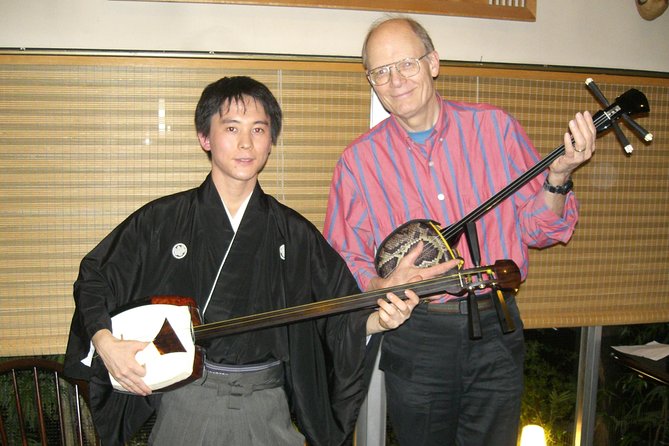
- Shamisen integrates traditional Japanese music with modern influences.
- Performance techniques blend historical narratives with contemporary expression.
- Shamisen’s unique sound and versatility symbolize Japan’s musical identity.
- Crucial role in Japanese cultural practices like kabuki theater and tea ceremonies.
Shamisen: The Japanese Traditional Instrument

Exploring the captivating melodies of the shamisen, a quintessential Japanese traditional instrument, unveils a rich tapestry of cultural heritage and musical artistry.
The construction of the shamisen involves a body made of wood with a skin stretched over it, and it’s typically tuned with three strings.
This unique instrument hasn’t only been integral to traditional Japanese music but has also made its mark in pop culture. From being featured in modern music compositions to making appearances in movies and anime, the shamisen continues to captivate audiences worldwide.
Its unmistakable sound and versatility have cemented its place as a symbol of Japan’s musical identity, bridging the gap between tradition and contemporary expression.
Origins and History of Shamisen
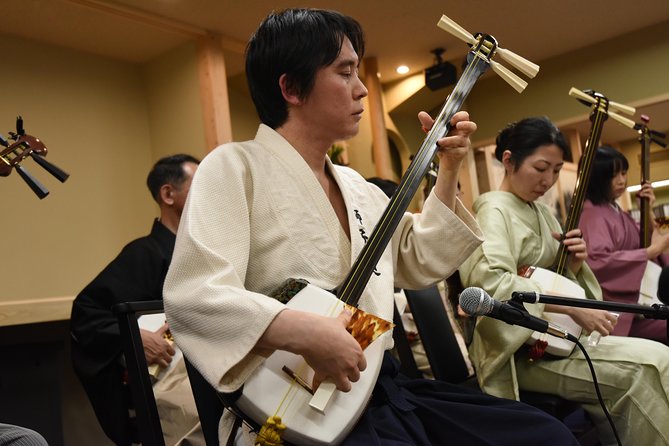
The Shamisen, deeply embedded in Japan’s cultural fabric, traces its origins and history through centuries of musical evolution and storytelling.
-
Evolution of Shamisen:
- The Shamisen’s roots can be traced back to the Okinawan sanshin and Chinese instrument sanxian.
- It evolved into its current form in the Edo period, becoming a prominent instrument in traditional Japanese music.
- Different styles of Shamisen playing emerged, such as the Tsugaru Shamisen known for its dynamic and percussive sound.
-
Cultural Significance:
- The Shamisen has been a crucial part of Japanese theatrical performances like Kabuki and Bunraku.
- It’s also often used in folk songs and min’yo, reflecting the everyday lives and emotions of the Japanese people.
- The instrument’s history is intertwined with Japan’s rich cultural heritage, making it a symbol of tradition and artistry.
Unique Characteristics of Shamisen Music
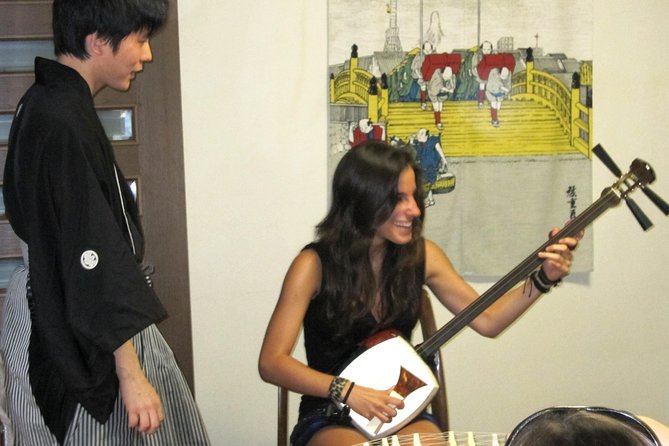
Enjoy the vibrant tapestry of Japanese traditional music as expressed through the distinct and evocative sounds of the Shamisen.
The unique characteristics of Shamisen music lie in its intricate techniques and profound cultural significance. Shamisen music is deeply rooted in Japanese culture, reflecting historical narratives, emotions, and traditions through its melodies.
The delicate plucking and striking of the Shamisen strings, combined with the use of a bachi (plectrum), create a rich and resonant sound that captivates listeners.
Beyond its traditional roots, Shamisen music has evolved to embrace contemporary adaptations, blending modern influences with age-old techniques. This fusion of past and present ensures that Shamisen music remains a dynamic and relevant art form in today’s diverse musical landscape.
Performance Techniques and Styles
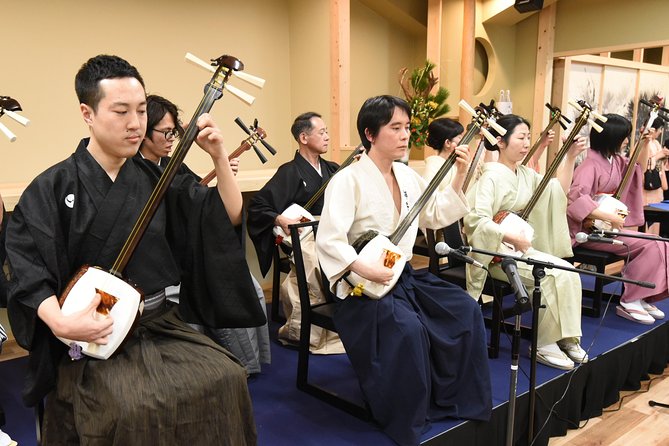
Delving into the world of Shamisen music reveals a tapestry of performance techniques and styles that intricately weave tradition with innovation.
- Contemporary adaptations: Shamisen music has evolved over time, incorporating modern elements while preserving its traditional essence.
- Cultural significance: The Shamisen holds a deep cultural significance in Japan, often being associated with historical tales and traditional performances.
- Performance etiquette, Regional variations: Different regions in Japan may have unique styles of playing the Shamisen, each with its own performance etiquette and nuances, adding to the rich tapestry of this musical tradition.
These elements contribute to the diverse and captivating nature of Shamisen music, showcasing the blend of old and new in a harmonious display of cultural heritage.
Influence of Shamisen in Japanese Culture
Shamisen music, deeply entrenched in Japanese culture, resonates across generations with its soul-stirring melodies and profound historical significance.
The influence of the Shamisen extends beyond music, shaping various aspects of Japanese art and cultural practices. In traditional Japanese art forms like kabuki theater and ukiyo-e woodblock prints, the Shamisen often serves as a key element, providing emotional depth and rhythm to performances.
Its cultural significance can also be seen in tea ceremonies, where the Shamisen sets the mood and enhances the overall experience. Through its distinctive sound and versatile nature, the Shamisen continues to play a vital role in preserving Japan’s rich cultural heritage and inspiring new generations of artists and musicians.
Modern Interpretations and Innovations

With a blend of tradition and contemporary flair, modern interpretations and innovations in Japanese music showcase the evolution of cultural expressions through the ages.
-
Modern adaptations: Artists are infusing traditional Japanese music with modern elements such as electronic beats, jazz influences, and rock instrumentation.
-
Cultural fusion: Collaborations with musicians from different genres and cultures are creating unique sounds that blend traditional Japanese instruments like the shamisen with Western instruments.
-
Innovative performances: Musicians are experimenting with new ways of presenting Japanese traditional music, incorporating visual projections, interactive elements, and immersive experiences to engage modern audiences while preserving the essence of the art form.
Common questions
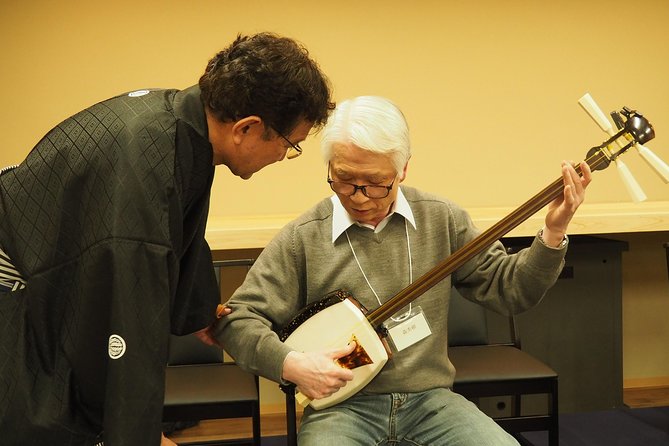
Can Audience Members Participate in the Traditional Japanese Music Show by Playing the Shamisen Themselves?
Audience members can enjoy traditional Japanese music by participating in the show. They have opportunities to play the shamisen, enhancing cultural engagement and providing a unique experience for those with instrumental background.
Are There Any Specific Dress Code Requirements for Attending the Japanese Traditional Music Show?
There is no specific dress code for attending the Japanese traditional music show. However, it is advisable to dress respectfully to fully immerse in the cultural experience. Understanding basic etiquette can enhance the overall enjoyment.
Is There a Specific Age Limit for Attending the Shamisen Performance?
Attendees of the Shamisen performance can expect to enjoy a rich cultural experience. There is no specific age limit for this event, making it accessible to all who wish to partake in the traditional music show.
Are There Opportunities for Audience Members to Interact With the Performers or Ask Questions During the Show?
During the show, audience members have opportunities for interaction and asking questions. Engage with the performers through Q&A sessions and live participation. Experience the traditional music firsthand with instrument demonstrations, creating a cultural and immersive experience.
Are Recordings or Merchandise of the Traditional Music Show Available for Purchase at the Venue?
Recordings of the show are available for purchase, offering a keepsake of the traditional music experience. The venue also offers merchandise options, allowing visitors to take home souvenirs and show memorabilia to cherish.
Last Words
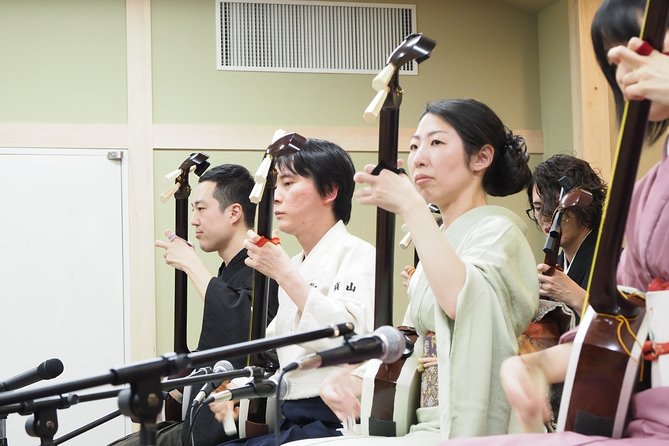
Enjoy the captivating world of Japanese traditional music with the mesmerizing sounds of the shamisen. From its rich history to its unique characteristics and influence in Japanese culture, the shamisen is a truly enchanting instrument that continues to inspire musicians and audiences alike.
With modern interpretations and innovative styles, the Japanese Traditional Music Show Created by Shamisen offers a harmonious blend of tradition and creativity that will leave you in awe.
Don’t miss out on this unforgettable musical experience!